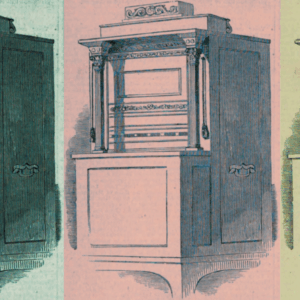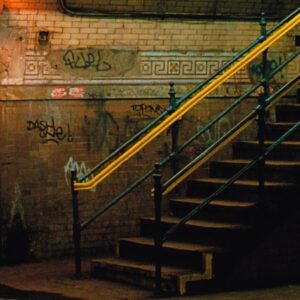Discussions of Jay DeFeo’s career tend to begin and end with The Rose (1958–1966), the physically and aesthetically massive sculpture (it weighs about a ton) that would come to emblematize her career. Fairly or unfairly, The Rose frames DeFeo’s mythology. Its rays, caught in emanation or contraction or both, capture much, if not all, of what figures into a postcard characterization of her work. Reproduced in a head-on photograph, the starburst seems deceptively flat, if arresting; seen otherwise, its dimensions (roughly, ten-and-a-half feet by seven and-a-half-feet by 11 inches thick) establish it as a native part of whatever edifice it hangs from. What sits at its center is neither a lacuna nor an unambiguous presence. The whole startling shape pushes up as a sea urchin might from beneath the gray that laps at its edges. At the same time, a feathery softness—reminiscent of Berkeley or San Francisco fog in early spring, both cities where DeFeo lived and practiced—erodes the harshness of its unnaturally straight lines. Beyond these discrete facets of the work, there is the persistent sense that a revelation is at hand: something indeterminate, maybe, or ominous—a revelation in the divine sense of that word, even if The Rose’s petals look more like spears threatening to skewer us on their axes rather than shower us in angelic shine.
The Rose displays literally the inverted compass rose that twirls in the hearts of all DeFeo’s works. Outwardly, its points settle on any number of wayward destinations; inwardly, they lead to the indefinite coordinates of its own location. This compass is unhelpful except as a means to tell us, in the manner of a tautology, that we are here—or that, if we could have the sort of transcendent experience that leads to the creation of such an artwork, we might go there. Even then it remains tight-lipped, auguring little.
Talk of grand visions—of which The Rose is certainly one—is indispensable, I think, to understanding DeFeo’s work, though the visionary was only one channel on the spectrum of modes into which she could dial. She was influenced not only by Blake but also by the Beat writers and artists whose influences overlapped with her own. She and husband Wally Hedrick lived for a time in the same building as Michael and Joanna McClure; when the McClures moved out, DeFeo and Hedrick took over their floor and converted their flat to a studio. And Hedrick helped found the Six Gallery, where Allen Ginsberg gave a wine-soaked first reading of “Howl.” But these histories—the ones she cited, and the ones that cited her—can distract from an appreciation of all the clutter and confusion (and occasional, blinding clarity) of DeFeo’s process. As with the corpuses of most artists worth studying, hers is strewn not only with genuine perceptions (like The Rose, many of which seem as surprising to DeFeo as they do to us), but also with endless attempts at sight itself.
The compressive tendencies of critics and narrative historians might wish to find in her work repeated vindication of the same themes, the same questions, the same preoccupations. And there is a way in which her corpus, seen from above, invites this. Rarely does she use bright colors. Mostly she traffics in a lexicon of rock and shadow—whites, grays, blacks, clayish browns and reds; the geological vocabulary of the earth before green and fleshly things came to be. Her primary concern seems always to be the forms of objects: how irreducible they are, but also how permeable, open, and flexible they could be when coaxed.
Any career that approached exhausting these themes would be remarkable enough. And yet DeFeo (1929-1989)—whose works, viewed individually, indisputably offer themselves up as achievements within these spare parameters—does more. The catch is that it takes an aerial view to see how. As the artist Billy Al Bengston advised in Artforum in 1969: “Never look at just one of Jay’s paintings.” The same goes for her works in other media, too, such as her smaller sculptures and jewelry-making projects. Viewed as a group, they make a strong case for how central repetition and multiplicity were to her practice. Like her more well-known pieces, they’re tinged with sobriety and skepticism about the forms and values of things, but in a different way. They’re lighter, zanier, and in a sense freer; marking DeFeo’s move into three-dimensional media, their limbs discharge pent-up energy. Seen together, their significance shifts and expands. They seem like a visual representation of a cacophony, the impromptu music of an orchestra tuning up, anxious to begin.
And then there are the bones. In November 1975, DeFeo wrote of her captivation at the sight of the bone from a roast leg of lamb as it sat in her soup pot. She took it out, photographed it, sketched it; she brought the sketch to a butcher the next week to buy a new bone after her dog, Merz, ate it. This bone, this artifact of an animal, sparked a series of works that bring—out of her own shadows—a different face of DeFeo’s practice. In place of The Rose’s occult and silent symbolism is a subject matter more seemingly familiar. Even as an archetype of life (a source of nourishment, a pillar of our composition) and death (the last parts of us to disintegrate), the bone is common. So common, even, that DeFeo’s bones seem at first to lack the bouquet of possibilities that works like The Rose furnished. The monumental size of that masterpiece encourages one to ask why it was made at all, this grisaille that bears a flower’s namesake. The bones, on the other hand, are less materially foreboding. Most were made on standard 8.5-by-11-inch copy paper, as ready at hand for an accountant as for an artist. They break with much of DeFeo’s corpus insofar as they readily articulate the object of their inquiry. They offer—or feign—a convincing transparency, a plainness.
![Jay DeFeo, Untitled (Bone series) [Estate No. E1943], 1975, graphite, oil pastel, and acrylic on paper, 11 X 8 1/2 inches, courtesy: The Jay DeFeo Trust](https://s26162.pcdn.co/wp-content/uploads/2015/09/DeFeo_E1943_RGB.jpg) Jay DeFeo, Untitled (Bone series) [Estate No. E1943], 1975, graphite, oil pastel, and acrylic on paper, 11 X 8 1/2 inches, courtesy: The Jay DeFeo TrustBut what the bones offer isn’t strictly lifelikeness. Each piece requires a few looks before the subject pops from the background, and perhaps even more looks for viewers already alert to DeFeo’s obsession with elision and fusion. What this untitled series of work offers instead is some mutant, punctured verisimilitude: in each piece they appear initially as bones, but after they appear as much else. In Untitled (Bone series, 1975) [Estate no. E1943], the bone seems definitively skull-like, its socket once the home of an eye, the vertical ridge of the bone mimicking the cartilage of a nose. With its irregular contours, the bone flickers into the guise of flesh.
Jay DeFeo, Untitled (Bone series) [Estate No. E1943], 1975, graphite, oil pastel, and acrylic on paper, 11 X 8 1/2 inches, courtesy: The Jay DeFeo TrustBut what the bones offer isn’t strictly lifelikeness. Each piece requires a few looks before the subject pops from the background, and perhaps even more looks for viewers already alert to DeFeo’s obsession with elision and fusion. What this untitled series of work offers instead is some mutant, punctured verisimilitude: in each piece they appear initially as bones, but after they appear as much else. In Untitled (Bone series, 1975) [Estate no. E1943], the bone seems definitively skull-like, its socket once the home of an eye, the vertical ridge of the bone mimicking the cartilage of a nose. With its irregular contours, the bone flickers into the guise of flesh.
The lines of graphite bring to mind tendons and sinews even as they highlight their absence; they give the bone a weightless quality, floating it above the surface on which it has been set. The smudged, imperfect color of the bone, more remarkable in this piece than in many of its series counterparts, is brought out by the crosshatching where the tip of the nose would be, were any nose ever there. The perspective doesn’t gaze down onto the bone, but at it, as though at a portrait; and this sense, combined with the positioning of the bone in the upper half of the piece, invites us to invent an out-of-frame body for this semi-recognizable head, while fully aware that the bone is no more facial than human in origin.
![Jay DeFeo, Untitled (Bone series) [Estate No. E1931], 1975, graphite and acrylic with cut out collage on paper, 11 x 8 1/2 inches, courtesy: The Jay DeFeo Trust](https://s26162.pcdn.co/wp-content/uploads/2015/09/DeFeo_E1931_RGB-233x300.jpg) Jay DeFeo, Untitled (Bone series) [Estate No. E1931], 1975, graphite and acrylic with cut out collage on paper, 11 x 8 1/2 inches, courtesy: The Jay DeFeo Trust
Jay DeFeo, Untitled (Bone series) [Estate No. E1931], 1975, graphite and acrylic with cut out collage on paper, 11 x 8 1/2 inches, courtesy: The Jay DeFeo Trust
Untitled (Bone series, 1975) [Estate no. E1931] evinces a similar technique, a similar trickiness. The bone’s shadow doesn’t consist of the graphite rain-lines of the prior work. Instead, it’s a pitch-black lightning bolt of cut paper into which we infer depth. Here, even more than in Untitled (Bone series, 1975) [Estate no. E1943], the bone seems to hover, as if magnetically repelling its background. The graphite strokes that mar the acrylic paint DeFeo used to evoke the impure, calcified surface aren’t nearly as regimented; they’re much more haphazard, suggesting the scratches and scars incurred as its meat was torn from it—or, perhaps, the dance of reflections in its polish as we crane to get a better view. The disorganized quality of the graphite lines abuts the starkness of the bone’s shadow, the latter completely distinct from the bone itself. Unlike Untitled (Bone series, 1975) [Estate no. E1943], where the lines used to capture the bone’s shadow also suggested absent tendons, here the shadow is its own being—an autonomous body, even. And the sharp right angle near its top seems at once fitting and artificial: fitting because the shadow as a whole, curved or not, feels productively displaced (as the bone has been from the organism), and artificial because such right angles hardly appear in nature.
So the shadow, not the bone itself, alerts us to the oddness of this angle. And what are we supposed to think about it? It isn’t perfect; but it’s close—so close, almost, that its minor imperfection, a little upturn at the vertex, might even be judged an imperfection in our own eyes and not in the object. DeFeo presses us to question, and ultimately rupture, the membrane of the oversimple concept of a bone that we probably applied when we first encountered these pieces. For in her hands, there is no longer any such concept. And no bone, either, but a constellation of details, none quite congruent—but somehow cohering.
The Bone series works by mechanisms different from those found in DeFeo’s better-known pieces. These untitled pieces are less symbolic—in one way. They lack the supercharged connotations that come with titling a work The Rose or Wings No. 1. Giving a work of art, abstract or otherwise, such a title is like installing it in a gallery where it can only be seen from one angle, or laying a sheet of tinted glass over it. One can only guess what the thing would look like were it seen from a different vantage or through clear or colored glass. But these guesses are thought experiments; their alternative realities are never quite reality. So it is with The Rose, whose title brings upon it a deluge of lore and history while pinning its meanings squarely to the corkboard of that supernatural flower. The bones, on the other hand, lack titles. DeFeo grouped them together in the same modest folder, under the same label; otherwise, as far as brute classification goes, they share only their subject.
![Jay DeFeo, Untitled (Bone series) [Estate No. E1934], 1975, graphite and acrylic with cut out collage on paper, 11 x 8 1/2 inches, courtesy: The Jay DeFeo Trust](https://s26162.pcdn.co/wp-content/uploads/2015/09/DeFeo_E1934_RGB-232x300.jpg) Jay DeFeo, Untitled (Bone series) [Estate No. E1934], 1975, graphite and acrylic with cut out collage on paper, 11 x 8 1/2 inches, courtesy: The Jay DeFeo TrustBut beneath the shared namelessness of these pieces lingers a web of interrelations and divergences. Untitled (Bone series, 1975) [Estate no. E1934] combines the histological, striated graphite lines of Untitled (Bone series, 1975) [Estate no. E1943] with the intensified naturalism of its red blotches; behind the bloodied, vaguely cruciform bone sits a tan shape whose curvature seems like a Cubist abstraction of the tissue from which the bone was cut. An outlier, Untitled (Bone series, 1975) [Estate no. E2865] presents a bone that is dark maroon to black, as if covered in dried blood, char, or gristle. Because of this, it seems more organic in its qualities than its counterparts; it sits cushioned in smudges of gray, which recall the oil and smoke of a kitchen—or, to scope further outward, the sea and sky. This cloud insinuates the bone’s decomposition, its contamination or fertilization of the nearby scene. The bone hangs in the middle of the page like a pendulum; a stray stroke of maroon simulates the drip of blood or jus. Unlike Untitled (Bone series, 1975) [Estate no. E1931] with its razor-edged shadow—something whose boundaries could never be in question—this singular work melds into its shadow, or its shadow into it; it leaks, it bleeds, it rubs off on the paper and on us. It resists DeFeo’s focus.
Jay DeFeo, Untitled (Bone series) [Estate No. E1934], 1975, graphite and acrylic with cut out collage on paper, 11 x 8 1/2 inches, courtesy: The Jay DeFeo TrustBut beneath the shared namelessness of these pieces lingers a web of interrelations and divergences. Untitled (Bone series, 1975) [Estate no. E1934] combines the histological, striated graphite lines of Untitled (Bone series, 1975) [Estate no. E1943] with the intensified naturalism of its red blotches; behind the bloodied, vaguely cruciform bone sits a tan shape whose curvature seems like a Cubist abstraction of the tissue from which the bone was cut. An outlier, Untitled (Bone series, 1975) [Estate no. E2865] presents a bone that is dark maroon to black, as if covered in dried blood, char, or gristle. Because of this, it seems more organic in its qualities than its counterparts; it sits cushioned in smudges of gray, which recall the oil and smoke of a kitchen—or, to scope further outward, the sea and sky. This cloud insinuates the bone’s decomposition, its contamination or fertilization of the nearby scene. The bone hangs in the middle of the page like a pendulum; a stray stroke of maroon simulates the drip of blood or jus. Unlike Untitled (Bone series, 1975) [Estate no. E1931] with its razor-edged shadow—something whose boundaries could never be in question—this singular work melds into its shadow, or its shadow into it; it leaks, it bleeds, it rubs off on the paper and on us. It resists DeFeo’s focus.
![Jay DeFeo, Untitled [Estate No. E3275], 1976, gelatin silver print, photomechanical reproduction, black gesso on cut-out paper and tape on paper, 17 3/8 x 14 inches, courtesy: The Jay DeFeo Trust](https://s26162.pcdn.co/wp-content/uploads/2015/09/DeFeo_E3275_RGB-243x300.jpg) Jay DeFeo, Untitled [Estate No. E3275], 1976, gelatin silver print, photomechanical reproduction, black gesso on cut-out paper and tape on paper, 17 3/8 x 14 inches, courtesy: The Jay DeFeo Trust
Jay DeFeo, Untitled [Estate No. E3275], 1976, gelatin silver print, photomechanical reproduction, black gesso on cut-out paper and tape on paper, 17 3/8 x 14 inches, courtesy: The Jay DeFeo Trust
Its inclusion in the series—as deviant, as experiment, as achievement, or as chimera bred from all these—points to the sense of persistence that saturates DeFeo’s catalogue. These bones are studies: studies of bodily relics, or of a relic, by which she improved her technical skills. But they are not only studies. Each is an isolated exercise as well as a phase of her grand, career-length exploration. The varieties of styles, techniques, and materials (graphite, acrylic, ink, oil pastel, collage) used to portray the bone attests to this tenaciousness. In each piece, DeFeo clarifies her, and our, relation to a part of the world—our relation to something in plain view on many dinner tables but hidden, always, beneath our skins. That at least some of these pieces are, and all of them feel to be, collages—amalgamations of shapes, shades, and perceptions—exposes the haziness of our understanding of this relation, calling into question the fixity and unity of the bone’s properties. Even Untitled (Bone series, 1975) [Estate no. E3281], Untitled (Bone series, 1975) [Estate no. E3275], and the pronouncedly divergent Wings No. 1, none of which seem to be portraits of a bone as such, recompile and rehearse the motif of the bone in their angularity, ruggedness, and affect.
The bone, as I suspect DeFeo knew, is a paradigm case of a thing whose limits, elements, and significances grow more obscure the more one scrutinizes it. Like the rose, the bone claims a special kind of attention. As archetype, it invokes mortality and frailty; it prompts us to examine the odd, and oddly material, substrate of our existence. While the rose oscillates between love and mere sentiment, purity and excess, the bone is by turns gorgeous and hideous, ordinary and grotesque, essential to the flourishing of animal health but also, somehow, a bad omen. Still, the threat of death needn’t be the bone’s main purchase on our imagination. Whatever unnerves us about our skeletal selves, and whatever pushed DeFeo to return to her lamb bone again and again—unsatisfied that she had seen it for what it really was—bones hold court inside our fragile cores, silent as stones, what will remain of us when the rest has gone.
![Jay DeFeo, Untitled [Estate No. P1625.3], 1972, gelatin silver print, 3 9/16 x 3 15/16 inches, courtesy: The Jay DeFeo Trust](https://s26162.pcdn.co/wp-content/uploads/2015/09/DeFeo_P1625.3_RGB.jpg) Jay DeFeo, Untitled [Estate No. P1625.3], 1972, gelatin silver print, 3 9/16 x 3 15/16 inches, courtesy: The Jay DeFeo Trust
Jay DeFeo, Untitled [Estate No. P1625.3], 1972, gelatin silver print, 3 9/16 x 3 15/16 inches, courtesy: The Jay DeFeo Trust
All images © 2015 The Jay DeFeo Trust / Artists Rights Society (ARS), New York.
Feature photo: Jay DeFeo working on The Jewel (1959) at 2322 Fillmore Street, 1959. Photograph by Jerry Burchard. © 2013 The Estate of Jerry Burchard
Andrew David King
Andrew David King’s work has appeared in Crab Orchard Review, Arroyo Literary Review, and The Rumpus, among other places. His poem “The Forever Thirst” appeared in ZYZZYVA No. 102.













